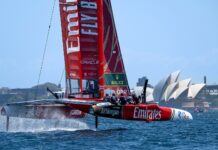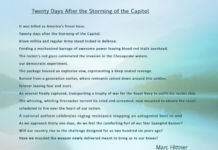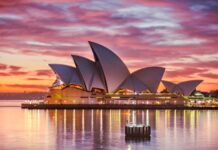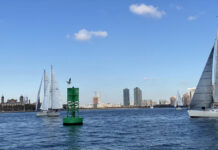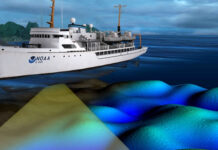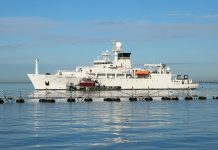BAYONNE’S ELCO POINT CRANE (40.694427, -74.111348)
A tranquil beach on the western shore of Bayonne, New Jersey holds a fascinating backstory of industrial greatness that once thrived in this stretch along Newark Bay. Today, in the surrounding area of Cape Liberty, Port Newark, and Port  Elizabeth, stand no less than one hundred heavy container cranes that dot the mechanized landscape, lifting and loading ships, trains, and tractors. But here at this spot is Rutkowski Park, only a memorial sleeps in the breeze. It is known as the Elco Point Crane. No longer in use, a single original crane has been carefully maintained by the City of Bayonne with its bright yellow steel superstructure and winches of copper cable. The historical plaque is testament to the ingenious technology of the 19th and 20th century and the contribution this spot served America in a span between the Civil War and World War II.
Elizabeth, stand no less than one hundred heavy container cranes that dot the mechanized landscape, lifting and loading ships, trains, and tractors. But here at this spot is Rutkowski Park, only a memorial sleeps in the breeze. It is known as the Elco Point Crane. No longer in use, a single original crane has been carefully maintained by the City of Bayonne with its bright yellow steel superstructure and winches of copper cable. The historical plaque is testament to the ingenious technology of the 19th and 20th century and the contribution this spot served America in a span between the Civil War and World War II.
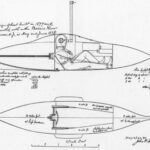 Let’s take a quick stop at the Elco Point Crane to fill your head with images of a former shipyard that spawned a multitude of motorized marine craft from a time long ago. To think, out of these tranquil waters, a metal plated submarine would rise from the depths of Newark Bay and float evenly on the water is mind blowing. It certainly was to the bystanders walking along the shoreline in 1895 as they witnessed a man popping his head out of the hatch offering a greeting. Local reporters would document the event at the time because the craft’s pilot, John P. Holland, the engineer and inventor, was incessantly busy building and testing his submersible prototypes first up the Passaic River and then eventually out into New York Harbor.
Let’s take a quick stop at the Elco Point Crane to fill your head with images of a former shipyard that spawned a multitude of motorized marine craft from a time long ago. To think, out of these tranquil waters, a metal plated submarine would rise from the depths of Newark Bay and float evenly on the water is mind blowing. It certainly was to the bystanders walking along the shoreline in 1895 as they witnessed a man popping his head out of the hatch offering a greeting. Local reporters would document the event at the time because the craft’s pilot, John P. Holland, the engineer and inventor, was incessantly busy building and testing his submersible prototypes first up the Passaic River and then eventually out into New York Harbor.
The All-Electric Boat Was Born in New York Harbor 150 years ago
In the 1880’s ambitious entrepreneurs were busy designing internal and external combustion engines for the automotive and marine industries. Batteries were an essential component needed to spark the new motor advancements. Issac Rice founded the Electric Storage Battery Company and at this spot, he partnered with Holland. The new shipyard produced Holland’s sixth design using Rice’s Exide battery to power the submersible. At the time, the U.S. Navy was hard set on steam engine power for the underwater craft; however, Holland’s quieter and durable electric powered submarine was approved and commissioned.
The one man fifty foot sub soon found its home across the harbor at the Brooklyn Navy Yard. With the success of U.S.S. Holland, Rice created the Electric Launch Company. The abbreviated ‘Elco’ moniker took hold as the Navy’s primary source for submarine development. Elco eventually grew into General Dynamics where fifty five years later, the first nuclear powered submarine was launched from Groton, Connecticut in 1954.
The Place Where The ‘Fast Boat’ Was Tested
The Elco Point Crane monument bears witness to the limited utilization of electric motorized craft. It was no coincidence that the all electric design worked for submersibles, but it could not satisfy the Navy’s need for greater rpms for its surface vessels. Combustion engines now ruled the waves. As the nation slowly recovered from the Great Depression of 1929, race boat designs followed suit and spawned new companies for a new American market.

Incredibly, Issac Rice’s Exide battery spawned something way more powerful over the next thirty years along the Newark Bay shoreline. The Patrol Torpedo, or “PT’, hull design was borrowed from Offshore Powerboat Racing, popular at the time with V-12 gas engines capable of reaching 75 mph, to fit the Navy category of a ‘Fast Boat’. The marine cranes at Elco Point lifted the PT fleet from the assembly line and delivered to the water’s edge for use in the Pacific Theatre of World War II. PT-109 was given life, commanded by the future 1960 President of the United States, John F. Kennedy.
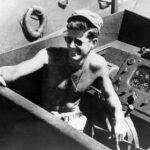
The Place Where Mercury Marine Marked Its Future
With the recreational boat industry booming, one such company was Mercury Marine, founded by Carl Kiekhaefer in 1939. Military contracts stimulated development of machines way beyond the scope of its intended purpose. Looking for new ways to support the fledgling business, Kiekhaefer’s motor was embraced by the nearby Wisconsin lumber industry when Mercury’s chainsaw became the fastest tool of the trade. Mercury Marine was awarded the chainsaw World War II era contract even when its boats failed to do so.
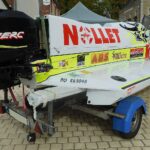
In 1947, Mercury Marine returned to their core business in a highly competitive market for recreational race boat designs. Fending off marine motor competition from the likes of Evinrude and Johnson, Kiekhaefer constantly redesigned his speed boat components. The race for the best speed boat was on every American lake, bay, and river. But the one event that turned the tide was the elusive 130 mile course from Albany down the Hudson River to New York Harbor. Mercury won in its class and never looked back. Mercury dominated the 1950’s by introducing its revolutionary “Thunderbolt” featuring its patented large outboard motor boasting a 4 cylinder in line, 40 horsepower engine.
The Place Where All-Electric Power Boats Will Inevitably Return
Mercury Racing created a dedicated elite division in 1973 and it heralded the entry into Formula One Race Boats. The muscle and roar of the combustion engine still reverberates fifty years later with its status symbol still strong living in a controversial world of E1 Series logo alternative energy sources. Formula One may soon take a back seat as Mercury Racing’s partnership with the international E1 Series carves its way into the all-battery marine race market characterized by lithium-ion.
AD:
Custom progamming, database and system support
Best custom computer programming, database and system work. https://custom-software-usa.com Custom Software USA
